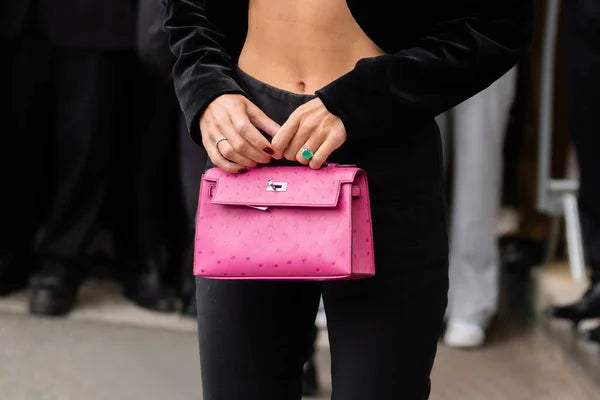
How Hermès Birkin Bags Are Made?
Hermès Birkin bags have earned cult status among luxury handbags, and they come with quite a hefty price tag. With prices ranging from $8,500 to over $300,000, the Hermès Birkin is not only a beautiful accessory – it's an investment item that outperforms gold or stocks. There are three elements that contribute to its extraordinary demand: exceptional quality in craftsmanship, deliberate scarcity of supply and classic style. In this article we'll explore the first element – namely how these bags are made – in more detail.
How Many Birkin Bags Are Made in a Year?
Hermès is revered for their craftsmanship and design when it comes to leatherwork. Of all the eighty models, the Birkin bag is in the highest demand. However, how many are actually made in a year? The true number is unknown; some sources have estimated up to 72,000. What we do know is that demand outweighs supply, driving prices higher and making this particular bag more exclusive. This scarcity tactic only bolsters its appeal across the globe.
Who Made the Birkin Bag?
The iconic Birkin bag has been a fashion symbol since it was created in 1983. Its story began during a conversation between Jean-Louis Dumas and Jane Birkin on board a flight to Paris when the idea for the handbag was born. The highly-skilled artisans of Hermès then worked tirelessly to perfect the design, ultimately producing the coveted Birkin bag.
What Are Birkin Bags Made Of?
Birkin bags are a fine example of luxury craftsmanship. These iconic handbags are made with the finest leathers, ranging from calfskin to more exotic skins such as alligator, ostrich, and lizard. Hermès owns tanneries across the globe to source the sophisticated materials used in their renowned creations.
How Are Birkin Bags Made?
At Hermes, crafting each Birkin bag is the work of a single artisan. This skilled craftsperson works for up to eighteen hours creating the one-of-a-kind item. Once it's complete, the bag is stamped with an identifying code that includes its year of creation, the artisan who made it, and workshop where it was produced. Let’s now take a more detailed look at how these exquisite pieces come together.
Choosing the Skin
The craftmanship of a Birkin bag begins with carefully selecting the appropriate skin. Artisans meticulously inspect each skin and mark any flawed areas such as mosquito bites before eradicating them to guarantee only high-quality skins are used. This is the starting point of creating a unique and perfect Birkin bag.
Cutting the Leather
Creating a high-quality Birkin bag requires precision in cutting the skin. Usually, only one piece of leather is used to create a single bag; however, larger sizes and/or unique skins may require more. For example, in the case of lizard skin, four to five pieces are typically needed for a small bag. By working with extreme care and attention to detail, the skilled crafters can make sure the handbag looks its best.
Stitching the Bag
The artisans at Hermès take special care to craft each and every Birkin bag, paying close attention to detail. The signature saddle stitch--utilized by the company since its inception as an equipment supplier for the French nobility--is made by hand using two needles, holding the skin securely in a wooden clamp. This stitch is extremely secure due to its design; even if one stitch were to break, it won't cause others to unravel. To complete this intricate process, waxed linen thread is employed for waterproofing and longevity of the product.
Ensuring Uniformity
A Birkin bag speaks of supreme quality and excellence. It has to be crafted with precision, from a single hide and must show uniformity in terms of size, shape, and details. The utmost care is given to its seams which are then shaved, sanded, or waxed. In addition, the balance between its characterizing leathers and scales (e.g., alligator or crocodile) must also meet Hermès' stringent criteria; a collector's standards of perfection may even reject an item if it does not measure up to expectations.
Creating the Handle
Each Birkin handle is crafted with great attention to detail. The handle is composed of several layers of rolled leather and requires up to four hours of work to complete. The same leather used on the rest of the bag is used for the handles and ensures a consistent texture throughout.
Placing the Hardware
The application of “pearling” is a key element in the installation of Hermès' precious metal hardware. This process involves attaching each piece with small nails, and then cutting, hammering, and polishing them until they are entirely smooth. Doing so guarantees secure touret, pontet, plaque, and clou pieces that give an elegant appearance and enhanced durability.
Inspecting the Bag
The making of a Birkin bag requires careful precision and attention to detail. Hermès inspects the product each step of the way, rigorously evaluating its quality before ultimately sending it off in an iconic orange box for further inspection at the Bobigny logistics department. For any bags that fail to pass, Hermès destroys them - underscoring their commitment to abiding by the highest standards of excellence.
Custom-Made Birkin Bags


